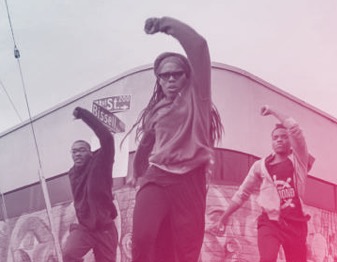
Frances Stark, The Whole of All the Parts…, 2011.
This is Stark’s first major multi-channel video installation. Many of the videos are bright white with thin lines of text blinking in the center, metered to the music of Haydn, S-Cat, and Lady Gaga. The strongest narrative emerges from a sex chat between an artist and a wealthy Italian architect. They tease each other along through the ambiguous medium of minimalist text. Each ultimately boasts that the other is “only a number,” one digit in a long line of sex partners. The fact that they are both using each other renders them impotent. The artist asks the architect to watch her film, explaining “this is the really brilliant part about fellinis 8 1/2 (sic) / it is so much about masturbation, that is why it is in my film.” By then we’ve seen the Fellini Saraghina bit, and the narrative folds in on itself. The artist’s film becomes the one we are currently watching, and the rumba of La Saraghina is a reflection of Stark’s earlier comparison of the artist to the prostitute (“the pressure to perform / resembles the pressure put / on sex workers to / always get it on.”)

Frances Stark, The Whole of All the Parts…, 2011.
If Frances Stark is quoting Fellini, Jonn Herschend might be quoting Jerry Seinfeld. Like Stark’s video, Herschend’s The Book You Said I Never Returned, plus three to five pastorals is an intricately constructed meta-narrative, albeit with humor as its course. Herschend leads his characters to stumble around the narrative of a missing book while revealing their own greed, self-interest, and ineptitude.

Jonn Herschend, The Book You Said I Never Returned…, 2011.
The story is told through an array of media, from printed text to video, PowerPoint, photograph, and installation. The gallery, Steven Wolf Fine Arts, is decorated with the Ikea-detritus of a run-of-the-mill office. A cubicle boxes out the center, and the walls are scattered with greenery, taupe-colored furniture, and fuzzy abstract paintings. A flash-lit photograph hangs on the far wall depicting the earmarked book. On the desk of the cubicle a smaller framed photograph (Frame Device, 2011) presents the entire installation in situ. In the photo you can see a photo on the desk, an infinitive feedback loop. (I spent a full minute staring and trying to figure out if this was physically possible. Steven Wolf tried to assist: “The photo within the photo is that photo without that photo.” Hmm.)
The installation is cloaked in irony. The paintings are produced by Herschend and are officially for sale, but only as part of the installation itself (“Price on request”), their value indistinguishable from that of the surge protector and filing cabinet. Lit by fluorescent lights, one painting is partially blocked by a pull-down projection screen that glows with a PowerPoint projection of black text on white background.
In the PowerPoints Herschend hits his stride. They begin in a distant, bulleted, third-person corporate voice (“A catalogue of the forest office”), but the emotional state of the person behind the presentation gradually takes over (“Oh, Lisa, we will start again”), their professionalism hijacked by pettiness.
Many of the references within The Book You Said… remain unclear until one reads a free take-away printed story. There the love triangle of characters is explicit, as is their role within a second video (Pastoral 5, 2011) and their plans to escape to an idyllic “forest office” on the lot behind their building (“we could run an extension cord through the men’s bathroom”).
Stark and Herschend are both strong writers. Treat yourself to some meta-narrative.
The Whole of All the Parts as Well As the Parts of All the Parts runs through December 11, 2011 at Mills College Art Museum. Stark will give a lecture there on December 7 at 7pm. For more information visit mcam.mills.edu.
The Book You Said I Never Returned, plus three to five pastorals runs through December 22, 2011 at Steven Wolf Fine Arts. For more information visit stevenwolffinearts.com.






